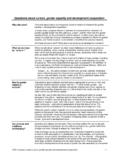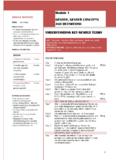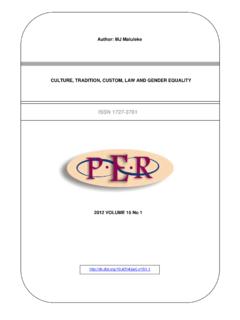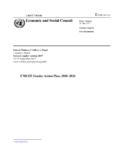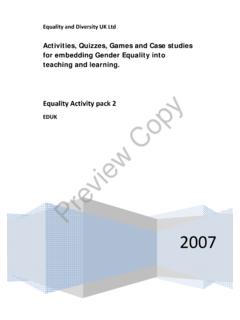Transcription of FAO POLICY ON GENDER EQUALITY
1 FAO POLICY . ON GENDER EQUALITY . Attaining Food Security Goals in Agriculture and Rural development Food and Agriculture Organization of the United Nations Viale delle Terme di Caracalla 00153 Rome, Italy ISBN 978-92-5-107490-9. Tel:(+39) 06 57051. 9 7 8 9 2 5 1 0 7 4 9 0 9. I3205E/1 1 2/24/13 12:50 PM. FAO POLICY . ON GENDER EQUALITY . Attaining Food Security Goals in Agriculture and Rural development Food and Agriculture Organization of the United Nations Rome, 2013. The designations employed and the presentation of material in this information product do not imply the expression of any opinion whatsoever on the part of the Food and Agriculture Organization of the United Nations (FAO) concerning the legal or development status of any country, territory, city or area or of its authorities, or concerning the delimitation of its frontiers or boundaries. The mention of specific companies or products of manufacturers, whether or not these have been patented, does not imply that these have been endorsed or recommended by FAO in preference to others of a similar nature that are not mentioned.
2 ISBN 978-92-5-107490-9. FAO 2013. FAO encourages the use, reproduction and dissemination of material in this information product. Except where otherwise indicated, material may be copied, downloaded and printed for private study, research and teaching purposes, or for use in non-commercial products or services, provided that appropriate acknowledgement of FAO as the source and copyright holder is given and that FAO's endorsement of users' views, products or services is not implied in any way. All requests for translation and adaptation rights, and for resale and other commercial use rights should be made via licencerequest or addressed to FAO information products are available on the FAO website ( publications) and can be purchased through Photo: Art direction and graphic design: Antonella Porfido CONTENTS. Acronyms IV. Foreword V. Introduction 1. Rationale 3.
3 FAO's GENDER EQUALITY goal and objectives 5. FAO's GENDER EQUALITY goal 6. FAO's GENDER EQUALITY objectives 7. FAO's GENDER EQUALITY strategy 9. Minimum standards for GENDER mainstreaming 10. Minimum standards for women-specific 12. targeted interventions Institutional mechanisms for implementation 13 and oversight Annex A: 16. FAO POLICY on GENDER EQUALITY accountability framework Annex B: 18. Responsibility for implementing FAO. GENDER equalityminimum standards Acronyms 1. IV ADG Assistant Director-General CEB United Nations System's Chief Executives Board for Coordination CEDAW Convention on the Elimination of All Forms of Discrimination Against Women CSF Finance Division (FAO). CSO Civil society organization CSP Human Resources Support Service (FAO). DG Director-General ECOSOC Economic and Social Council (UN). ESA Agricultural development Economics Division (FAO).
4 ESS Statistics Division (FAO). ESW GENDER , Equity and Rural Employment Division (FAO). FAO Food and Agriculture Organization of the United Nations FAOR FAO Representative GFP GENDER Focal Point HQ Headquarters (FAO). OCP Office for Communication, Partnerships and Advocacy (FAO). OED Office of Evaluation (FAO). OEK Office of Knowledge Exchange, Research and Extension (FAO). OHR Office of Human Resources OIG Office of the Inspector General (FAO). OSD Office of Support to Decentralization (FAO). OSP Office of Strategy, Planning and Resources Management (FAO). PEMS Performance Evaluation and Management System RO Regional Office SWAP UN System-Wide Action Plan on GENDER EQUALITY and the Empowerment of Women TCE Emergency Operations and Rehabilitation Division (FAO). TCP Technical Cooperation Programme (FAO). TOR Terms of Reference UDHR Universal Declaration of Human Rights UN United Nations 1.
5 The names and related acronyms of units within FAO were accurate as of November 2012; it is noted that these names may change due to structural reforms. FOREWORD. On International Women's Day, 8 March 2012, I officially V. announced the adoption of FAO's new corporate POLICY on GENDER EQUALITY . With this POLICY , I wish to underscore the Organization's and my own commitment to promoting GENDER EQUALITY and women's empowerment as a key to eradicating hunger and poverty worldwide. Women make crucial contributions in agriculture and rural enterprises. Women play a key role in rural economies, where the fight against hunger and poverty is most pressing, as this is where the large majority of the world's poor live. They are also central to family food security and nutrition, as they are generally responsible for food selection and preparation and for the care and feeding of children.
6 Women manifest an impressive resilience and multifaceted array of talents, but they also face a range of constraints particularly in their access to productive resources such as land, inputs, training and financial services which prevent them from becoming equally competitive economic players, capable of creating better lives for themselves and their families, and contributing fully to the growth of their communities and countries. We now have proof that closing this GENDER gap in agriculture and in other aspects of rural life could bring about significant developmental advances. Simply by giving women the same access to productive resources as men have, yields on women's farms would increase significantly, and substantial progress would be made in lifting millions out of food insecurity. Moreover, bridging this gap would put more resources in the hands of women and strengthen their voice within the household a scenario that has proved to have multiplier effects on the food security, nutrition, education and health of their children.
7 And better-fed, healthier children learn better, become more productive citizens and foster more innovative rural societies. Clearly, the benefits would span generations and yield large dividends in the future. The importance of investing in rural women as a channel for progressive change is significant. At the same time, as cultural realities come into play, the achievement of greater empowerment and EQUALITY also implies a strong engagement with both men and women. Cultural and behavioural change is integral to the transformation of VI Women's full and equal intra- and extra-household dynamics, and is a prerequisite for greater participation in the GENDER and social EQUALITY . In some cases, GENDER gaps are reversed, political and economic with men and boys experiencing marginalization or missing potential. arena is fundamental to democracy and Thus, engaging women, men, girls and boys in the development justice, which people are process is vital.
8 Demanding. Equal rights and opportunity underpin Reducing GENDER inequalities in the agriculture sector clearly healthy economies and holds great promise for FAO's mandate of reducing hunger, poverty societies. and injustice in the world. For this reason I have requested and put in place an official FAO POLICY on GENDER EQUALITY . Formulated Michelle Bachelet after an extensive consultation process, the POLICY provides a UN Women Executive Director framework to guide and assess FAO's work in this area. It specifies (2012) roles and responsibilities for the implementation of POLICY directives, and delineates a number of objectives and minimum standards for the achievement of an overall goal. This goal aims for EQUALITY Achieving women's between men and women in sustainable food production and rural EQUALITY is a fundamental development , for the elimination of hunger and poverty.
9 The goal and human right and a social standards expressed within the POLICY are firmly in line with United and economic imperative. Nations system standards in this area, rendering it both progressive Where women are educated and empowered, and consistent with the latest thinking. economies are more productive and strong. I stand firmly behind the POLICY on GENDER EQUALITY , calling on Where women are fully everyone to uphold the principles upon which it is based and ensuring represented, societies that all of FAO's work pays due attention to reducing GENDER and are more peaceful and social inequalities. The basic tenets are clear. We must eliminate all stable.. forms of discrimination against women under the law, ensure that Ban Ki-moon access to resources is more equal and that agricultural policies and UN Secretary General programmes are GENDER -aware, and make women's voices heard in (2010).
10 Decision-making at all levels. Women must be seen as equal partners in sustainable development , because they have as much to give as they need to receive. In the end, achieving GENDER EQUALITY and empowering women is not only the right thing to do; it is also a crucial ingredient in the fight against poverty and hunger. Jos Graziano da Silva Director-General Food and Agriculture Organization of the United Nations INTRODUCTION. GENDER EQUALITY is central to the Food and Agriculture Organization GENDER EQUALITY is 1. of the United Nations' (FAO's) mandate to achieve food security for central to the Food and Agriculture Organization of all by raising levels of nutrition, improving agricultural productivity the United Nations' (FAO's). and natural resource management, and improving the lives of rural mandate to achieve populations. FAO can achieve its goals only if it simultaneously food security for all by works towards GENDER EQUALITY and supports women's diverse roles raising levels of nutrition, improving agricultural in agriculture and rural development .










